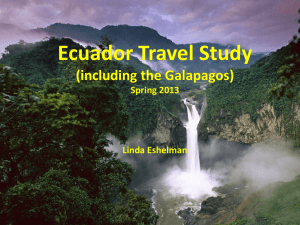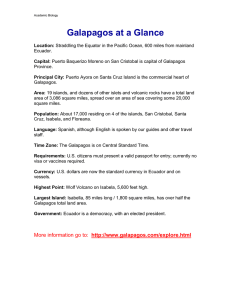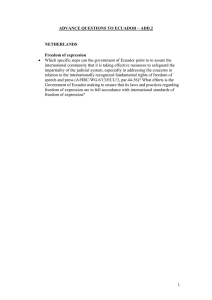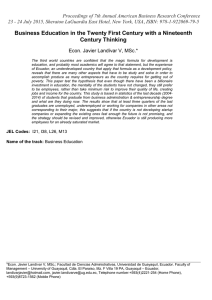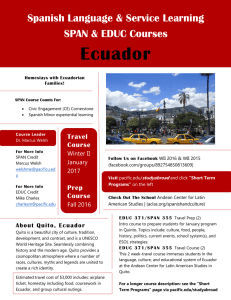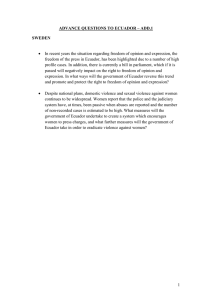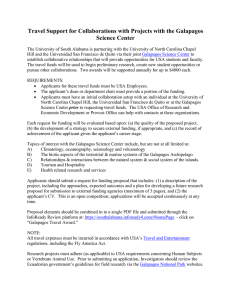to a PDF version of our travel
advertisement
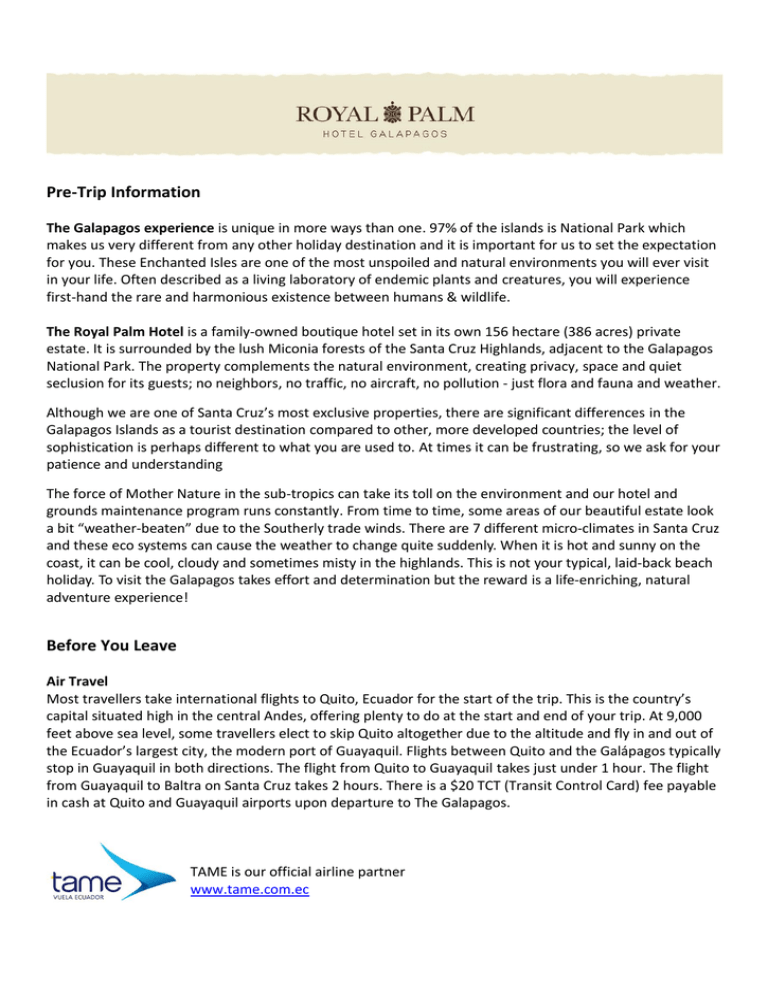
Pre-Trip Information The Galapagos experience is unique in more ways than one. 97% of the islands is National Park which makes us very different from any other holiday destination and it is important for us to set the expectation for you. These Enchanted Isles are one of the most unspoiled and natural environments you will ever visit in your life. Often described as a living laboratory of endemic plants and creatures, you will experience first-hand the rare and harmonious existence between humans & wildlife. The Royal Palm Hotel is a family-owned boutique hotel set in its own 156 hectare (386 acres) private estate. It is surrounded by the lush Miconia forests of the Santa Cruz Highlands, adjacent to the Galapagos National Park. The property complements the natural environment, creating privacy, space and quiet seclusion for its guests; no neighbors, no traffic, no aircraft, no pollution - just flora and fauna and weather. Although we are one of Santa Cruz’s most exclusive properties, there are significant differences in the Galapagos Islands as a tourist destination compared to other, more developed countries; the level of sophistication is perhaps different to what you are used to. At times it can be frustrating, so we ask for your patience and understanding The force of Mother Nature in the sub-tropics can take its toll on the environment and our hotel and grounds maintenance program runs constantly. From time to time, some areas of our beautiful estate look a bit “weather-beaten” due to the Southerly trade winds. There are 7 different micro-climates in Santa Cruz and these eco systems can cause the weather to change quite suddenly. When it is hot and sunny on the coast, it can be cool, cloudy and sometimes misty in the highlands. This is not your typical, laid-back beach holiday. To visit the Galapagos takes effort and determination but the reward is a life-enriching, natural adventure experience! Before You Leave Air Travel Most travellers take international flights to Quito, Ecuador for the start of the trip. This is the country’s capital situated high in the central Andes, offering plenty to do at the start and end of your trip. At 9,000 feet above sea level, some travellers elect to skip Quito altogether due to the altitude and fly in and out of the Ecuador’s largest city, the modern port of Guayaquil. Flights between Quito and the Galápagos typically stop in Guayaquil in both directions. The flight from Quito to Guayaquil takes just under 1 hour. The flight from Guayaquil to Baltra on Santa Cruz takes 2 hours. There is a $20 TCT (Transit Control Card) fee payable in cash at Quito and Guayaquil airports upon departure to The Galapagos. TAME is our official airline partner www.tame.com.ec Contact Royal Palm Hotel Galapagos Address: Km. 18 Via Puerto Ayora-Baltra, Isla Santa Cruz, Galapagos, Ecuador Tel: + 593-5-252-7408/9 Direct enquiries and bookings tel: + 593-2-252-0000 Email: Info@royalpalmgalapagos.com Web: www.royalpalmgalapagos.com Documentation Valid passport Emergency contact numbers Copy of the picture page from your passport US $ currency Airline tickets Travel Insurance Hotel confirmation Pre booked tour confirmation As of August 2008 visitors to Ecuador no longer require a visa but there are exceptions. The following countries do still require a tourism visa to enter Ecuador: Afghanistan, Bangladesh, Eritrea, Ethiopia, Kenya, Nepal, Nigeria, Pakistan and Somalia. ID Ecuador requires travellers to carry photographic proof of identity and some form of legal identity on them at all times. You may also be asked to show your passport when making large purchases with credit cards while in Ecuador. The Galapagos is a little more relaxed, you won’t need any official documents unless you plan to make a purchase using credit cards. Medical No inoculations are required for travel to the Galapagos Islands, please consult with your doctor 4 - 6 weeks before your trip to discuss any health precautions you may wish to take. The Royal Palm has access to the local clinic and doctors who can assist with basic ailments. The nearest fully equipped hospital is in Guayaquil on the mainland. Although there are mosquitoes in Galápagos, none of them are carriers of malaria or dengue fever. Anti- malarial medicines are not essential but just a good mosquito repellent. Due to the high elevations, if you are flying in or out of Quito (9,000 ft / 3,000 m) and have high blood pressure or a heart condition, please seek your doctor’s advice before traveling. Those who should avoid high elevations may prefer to fly in and out of the city of Guayaquil rather than Quito. Money The US Dollar is the official currency of Ecuador. When traveling it is wise to make sure you bring a selection of small bills (for tipping). It is also a good idea to carry an amount of change with you since coins can be difficult to come by and if you do not have the coins needed the bill is frequently rounded up to the next dollar amount. We suggest:• $100 cash for Galapagos Park Fee (payable on arrival into Baltra) • $20 cash for the Galapagos Tourist Transit Card (payable at the departure point) • Collection of low denomination bills for tips and miscellaneous Items • Credit Cards Credit Cards including American Express, Diner's Club, Visa and Master Card are widely accepted in the tourist areas. Some businesses add a surcharge from 6% - 10% for transactions paid by credit card. Packing for the Galapagos Sun hat Small backpack Shorts T-shirt or vest Sweat shirt Light pants Water and wind-proof jacket Walking shoes High factor sun block Reef sandals Sunglasses Swimwear Camera Binoculars Travel Insurance Doctors, clinics and hospitals often expect immediate cash payment for health services. Many hospitals do not accept credit cards. The Royal Palm and associated tours will apply cancellation fees for late cancellation. Please ensure that you are travelling with sufficient travel and medical insurance cover. Click here for booking terms and conditions. www.royalpalmgalapagos.com/booking-terms-conditions/ When you Arrive Banking Hours & ATMs Banking hours are from 09:00 to 18:00 Monday to Friday on Santa Cruz. ATM machines are located in all major towns. Galapagos National Park Entry Fees The GNP charges an entrance fee per person payable in cash upon arrival at Baltra Airport. Non-residents of Ecuador over 12 years US $100 Non-residents of Ecuador under 12 years US $50 Residents of Ecuador, over 12 years US $6 Residents of Ecuador, under 12 years US $3 Non-residents/students of Ecuador who are enrolled in national educational institutions US $25 NOTE: Children under 2 years of age are exempt Language The official language of Ecuador is Spanish. However, English is widely spoken at hotels, restaurants and shops. Almost everyone involved in hosting you during your stay speaks English. Power Voltage: 110 volts. Sockets are a mixture of the European, two-pronged round variety and US flat-pin. Time Zones The Galápagos Islands are one hour behind the mainland and 7 hours behind GMT. Tipping & Gratuities We are often asked what gratuity is appropriate to leave your guide and other staff while in the Galápagos. Of course the quality of service should determine the extent of any gratuity. It is customary to leave a tip of 10% on any restaurant bill and to tip taxi drivers, guides and crews as you see fit. Transfers The transfer from Baltra airport to The Royal Palm takes around 1½ hours. Once you have cleared customs and collected your luggage, look out for a welcome board with your name on it. (Please remember to arrange your transfers in advance.) There is a 10 minute drive by bus to the Itabaca Channel which divides Baltra Airport from Santa Cruz Island. The ferry crossing takes about 10-15 minutes. The driver will meet you at the other side and will take you to the Hotel. The transfer fee is $35 per person each way, on a shared basis. Private transfers are available by prior arrangement. Please ensure that you have advised us of your arrival date, flight number & time and we encourage you to book your transfers in advance. The only public buses are run by the airlines (TAME, LAN & Avianca formerly AeroGal) and their timetable and charges do vary! Please be aware that there are no taxi ranks on Santa Cruz. When you arrive at the Royal Palm, a Highland Mist welcome drink awaits you at reception, and once you have check-in, your holiday begins! Feel free to settle into you Villa or Casita and explore the estate. The hotel team is always available to check your itinerary and help you with any other arrangements to ensure a happy and memorable stay. Water The water that comes through the taps and showers in the hotel is rain water which is filtered through natural volcanic rock and chlorinated enough to make it skin-safe! Bottled water is provided in every room; it is recommended that you drink only this. There is a water station at the entrance to the Restaurant, for unlimited refills of bottles and canteens. Weather The Galápagos sit on the equator, so seasonal temperatures vary only slightly. The climate is subtropical making the Galapagos is a year-round destination with average low temperatures of 18–21C° / 65-70F° and highs of 85-90F° / 29-32C°. There are two main weather seasons: The “warm, dry season” runs Dec/Jan to May/Jun and is the hottest time of year, with air temperatures in the upper 80°s F (30°s C). There is usually plenty of blue sky and sunshine; rain showers tend to be typically tropical mainly in Jan/Feb and the water quickly drains through the porous volcanic terrain. The sun is at its most intense and the sea is at its warmest and calmest. The cool, wet “Garua” season lasts from June/July through Nov/Dec. The Garua is a fine drizzle that often falls over the Highlands in the early mornings and sometimes throughout the day. The sun is less intense, with cloudier skies. Air temperature is lower, with highs in the mid 60°s to high 70°s F (15 – 25° C) depending on the month. Due to our elevated location in the Highlands, rain and cloud is common at this time of year, but once you are out on your excursions, you will usually have sunny days! Weather calendar January February March / April May / June July / August August Sept / Oct / Nov December Rainy and warm season (until May). Water and air temperature rise until June. Best underwater visibility (until March) Highest water temperature (reaches 25°C / 79°F) until April Rainy season reaches its peak. Sporadic tropical rains, intense sun and hot climate. Air temperature reaches 31°C / 91°F Beginning of the Garua season (cool, dry season until December) Windiest months (force 4 – 5) Lowest sea water temperatures (21.5 c / 71 F) Lowest air temperature (24°C / 77°F) Humboldt current is strongest – strong ocean currents Start of the warm season Weather – El Niño and La Niña El Niño and La Niña are complex, atmospheric weather patterns resulting from variations in oceansurface temperatures in the East-Central Pacific Ocean. La Niña is referred to as the cold phase and El Niño is the warm phase. These deviations from normal surface temperatures can have large-scale impacts not only on the seas and currents, but also on our weather and climate, globally as well as locally. We are now entering an El Niño phase of activity which happens when the average temperature of the Pacific Ocean increases. This in turn can cause heavy rainstorms in parts of Latin America, mainly in countries below the Equator line of Ecuador, including Bolivia, Paraguay, Peru, Argentina and Brazil. This is quite normal for this region and we ask for your patience and understanding, if you experience delays or changes to your itinerary. Your comfort and safety is our top priority. Temperature chart Average air temperatures Month Jan Feb Mar Apr May Jun Jul Aug Sep Oct Nov Dec Max ºC 30 30 31 31 28 26 26 26 26 26 26 27 Min ºC 22 24 24 24 22 21 20 19 19 20 21 22 Max ºF 86.0 86.0 87.8 87.8 82.4 78.8 78.8 78.8 78.8 78.8 78.8 80.6 Average sea temperatures Min ºF 71.6 75.2 75.2 75.2 71.6 69.8 68.0 66.2 66.2 68.0 69.8 71.6 ºC 24.5 25 25 25 24.5 23 22 21.5 22 22.5 23 23.5 ºF 76.1 77.0 77.0 77.0 76.1 73.4 71.6 70.7 71.6 72.5 73.4 74.3 Average hours of clear sky 5.3 7.5 6.0 7.5 5.2 4.4 2.8 3.3 2.9 3.8 3.5 4.0 Average monthly rainfall inches 2.4 4.6 4.0 2.9 0.6 0.2 0.3 0.2 0.2 0.2 0.2 0.3 mm 60.9 116.8 101.6 73.7 15.2 5.08 7.62 5.08 5.08 5.08 5.08 7.62
